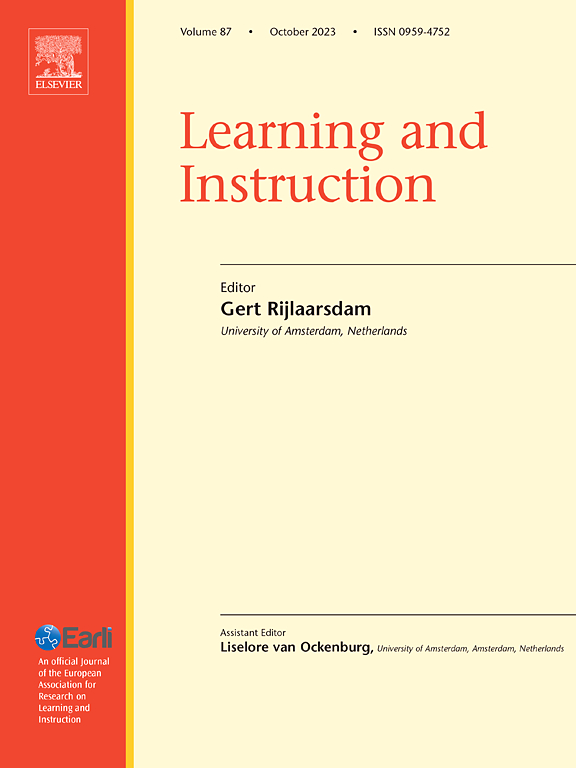Do worked examples boost the spacing effect on lasting learning?
IF 4.9
1区 教育学
Q1 EDUCATION & EDUCATIONAL RESEARCH
引用次数: 0
Abstract
Background
The acquisition of lasting knowledge that is accessible for a long time is an important educational goal. Spacing the learning or practice phase across multiple sessions fosters lasting learning, but the effect is less robust for complex material.
Aims
We examined whether the meaningful elaboration of the learning material, evoked by means of self-explaining worked examples, contributes to a more robust spacing effect concerning the lasting learning in mathematics.
Sample
Participants were fourth graders (N = 213).
Methods
Children received a formal instruction to long multiplication in school. Thereafter, they practiced the procedure either in a massed or a spaced manner, and either by pure problem solving or by additionally self-explaining worked examples in their regular math lessons. Time on task was held constant in all conditions. In a delayed test after eight weeks, children's procedural and conceptual knowledge was assessed. Their general math ability and their specific prior knowledge served as control variables.
Results
Contrary to our expectations, there was neither a main effect of worked examples nor of spacing, and no interaction emerged between the two variables. Exploratory analyses revealed the same results concerning the forgetting rate between the last practice set and the test. These null effects were confirmed by Bayesian analyses. Only children's general math ability and their prior knowledge predicted their test performance.
Conclusions
The results suggest that the spacing effect in mathematics does not emerge reliably, even not when stimulated by worked examples. Further research on potential boundary conditions is required.
工作实例对持久学习有促进间隔效应吗?
获得长期可用的持久知识是一个重要的教育目标。将学习或练习阶段间隔在多个课程中可以促进持久的学习,但对于复杂的材料,效果就不那么明显了。目的:我们研究了通过自我解释的工作实例,对学习材料进行有意义的阐述,是否有助于在数学持久学习中产生更强的间隔效应。样本参与者为四年级学生(N = 213)。方法在学校对儿童进行正式的乘法学习。之后,他们以大量或间隔的方式练习这个过程,或者通过纯粹的问题解决,或者在常规的数学课上额外地通过自我解释的工作例子来练习。完成任务的时间在任何条件下都保持不变。在八周后的延迟测试中,评估了儿童的程序性和概念性知识。他们的一般数学能力和特定的先验知识作为控制变量。结果与我们的预期相反,工作实例和间距都没有主要影响,并且两个变量之间没有相互作用。探索性分析表明,在最后一组练习集和测试集之间的遗忘率结果相同。贝叶斯分析证实了这些无效效应。只有儿童的一般数学能力和他们的先验知识才能预测他们的测试成绩。结论数学中的间隔效应并不可靠地出现,即使在实例的刺激下也不可靠。需要进一步研究潜在的边界条件。
本文章由计算机程序翻译,如有差异,请以英文原文为准。
求助全文
约1分钟内获得全文
求助全文
来源期刊

Learning and Instruction
Multiple-
CiteScore
11.30
自引率
4.80%
发文量
109
期刊介绍:
As an international, multi-disciplinary, peer-refereed journal, Learning and Instruction provides a platform for the publication of the most advanced scientific research in the areas of learning, development, instruction and teaching. The journal welcomes original empirical investigations. The papers may represent a variety of theoretical perspectives and different methodological approaches. They may refer to any age level, from infants to adults and to a diversity of learning and instructional settings, from laboratory experiments to field studies. The major criteria in the review and the selection process concern the significance of the contribution to the area of learning and instruction, and the rigor of the study.
 求助内容:
求助内容: 应助结果提醒方式:
应助结果提醒方式:


